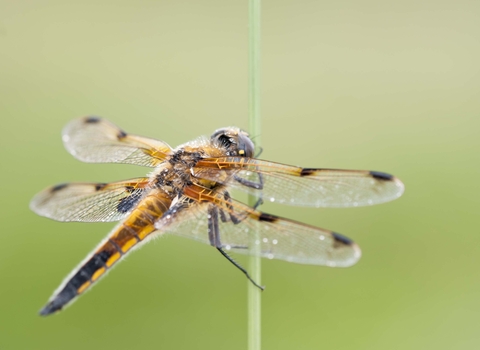
©Ross Hoddinott/2020VISION
Four-spotted chaser
The Four-spotted chaser is easily recognised by the two dark spots on the leading edge of each wing - giving this species its name. It can be seen on heathlands and near ponds and lakes.
Scientific name
Libellula quadrimaculataWhen to see
May to SeptemberSpecies information
Category
Statistics
Length: 3.9-4.8cmCommon.
About
The Four-spotted chaser is a medium-sized, fairly broad-bodied dragonfly. It is on the wing from May to September, sometimes even into October. It is commonly found on heathland and moorland, as well as around ponds, lakes and in woods. Four-spotted Chasers are active dragonflies, spending a lot of time hawking over water for insect-prey or to mark out their territories. They mate on the wing; the female then hovers over the water, dipping the tip of her abdomen into drop her eggs on to vegetation below the surface.How to identify
Both sexes of the Four-spotted chaser are golden-brown, getting darker towards the tip of the body, and with yellow spots along the sides. Two dark spots at the front edge of each wing give this dragonfly its name and an easily recognisable appearance.Distribution
Widespread.In our area
Across Shropshire you will see the Broad-bodied Chaser basking in the sun around ponds and wetland areas. Keep an eye out at the Meres and Mosses in the North of the county and you may spot these stunning invertebrates.
Did you know?
Enormous migrating swarms of Four-spotted chasers have been recorded in Europe.Watch
Across Shropshire you will see the Broad-bodied Chaser basking in the sun around ponds and wetland areas. Keep an eye out at the Meres and Mosses in the North of the county and you may spot these stunning invertebrates.

